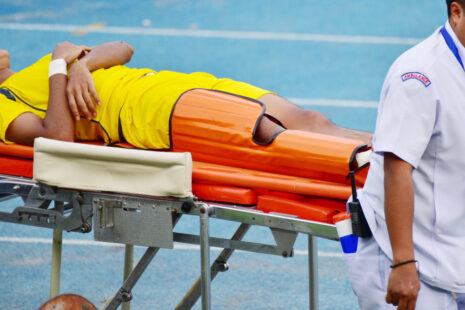Soccer is considered a moderate- to high-impact sport, depending on various factors such as the level of play, style of play, and individual player characteristics.
Here are some reasons why soccer is classified as a moderate- to high-impact sport…
- Running and Sprinting – Soccer involves significant running, sprinting, and jogging throughout the duration of a match. The repetitive impact of foot striking the ground while running can place stress on the lower body joints, particularly the ankles, knees, and hips.
- Jumping and Landing – Players often jump to head the ball or reach for aerial passes, which can result in high-impact landings on the ground. Jumping and landing activities can place stress on the lower body joints and may increase the risk of lower extremity injuries, such as ankle sprains and knee injuries.
- Physical Contact – Soccer is a contact sport that involves physical challenges for the ball, such as shoulder-to-shoulder contact, challenges for aerial balls, and collisions between players. Physical contact can result in impact forces being transferred to various parts of the body, leading to bruises, contusions, and other injuries.
- Change of Direction and Agility – Soccer requires rapid changes of direction, quick accelerations, and decelerations to evade defenders, change the direction of play, or position oneself for a shot on goal. These dynamic movements can place stress on the lower body joints and increase the risk of musculoskeletal injuries, particularly if performed incorrectly or excessively.
- Playing Surface – The type of playing surface can also influence the impact forces experienced by soccer players. Playing on natural grass surfaces may provide some cushioning and shock absorption compared to artificial turf or hard surfaces, which can increase the impact forces transmitted to the body during running, jumping, and landing activities.
- Injury Risk – Soccer players are susceptible to a variety of injuries, including sprains, strains, fractures, and ligament tears, due to the physical demands and impact forces associated with the sport. Common soccer-related injuries include ankle sprains, knee ligament injuries (such as ACL tears), muscle strains, and contusions.
While soccer can be a high-impact sport, proper training, conditioning, technique, and injury prevention strategies can help reduce the risk of injuries and promote safe participation for players of all ages and skill levels. Warm-up exercises, strength training, flexibility training, and adherence to proper playing techniques can help mitigate the impact forces experienced by soccer players and improve overall performance and resilience on the field.




